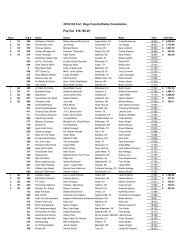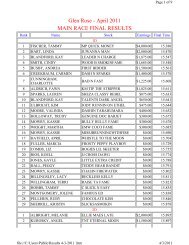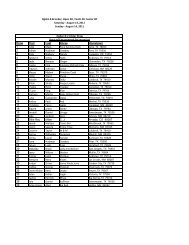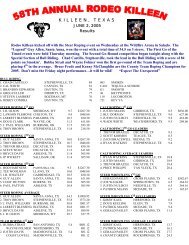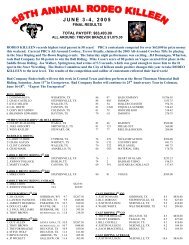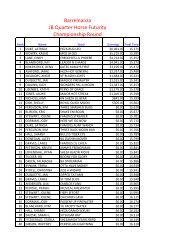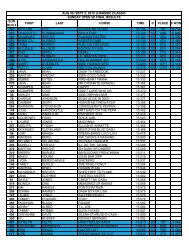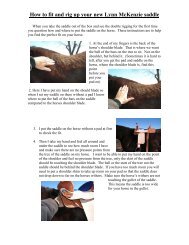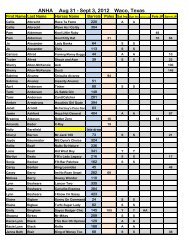tanner pages - Lynn Mckenzie saddles & Tanner Time
tanner pages - Lynn Mckenzie saddles & Tanner Time
tanner pages - Lynn Mckenzie saddles & Tanner Time
Create successful ePaper yourself
Turn your PDF publications into a flip-book with our unique Google optimized e-Paper software.
THE SCIENCE OF SPEEDUnderstanding the mechanics of barrel racing - increase speed andimprove your times with help from <strong>Lynn</strong> McKenzie and <strong>Tanner</strong> <strong>Time</strong>COMPARISONREPORTHow to read a <strong>Tanner</strong> time reportAt the top of a <strong>Tanner</strong> <strong>Time</strong> diagram, the rider’s draw number, Pen (penalties fromknocked-down barrels), Raw time (time without penalties), Pen time (Penalty timeadded) and Total time (time with penalties added) are listed.I -1: <strong>Time</strong> from the start line to 1st barrel1(1: <strong>Time</strong> around 1st barrel1-2: <strong>Time</strong> between 1st and 2nd barrels2(2: <strong>Time</strong> around 2nd barrelTHE SYMBOLSRaw ------------------------------------------------------------<strong>Time</strong>: Rider’s time without penalties.2-3: <strong>Time</strong> between 2nd and 3rd barrels3(3: <strong>Time</strong> around 3rd barrel3-0: Run out from 3rd barrel to moneylineTotal straights: the four straight segments added together [I-1, 1-2, 2-3, 3-0]Total Turns: ((( the three turn times added together [1(1, 2(2, 3(3](Total times give a quick overall view to compare to the race winner’s totals. This willtell if you have a “running” horse or a “turning” horse.)Comparing your time to seven othersThe first box at the bottom of the page (Top Three Overall) shows the segmentedtimes for the top three runs of the show. “Avg <strong>Time</strong>s” are the averaged times of the topthree placers, which is what your run is compared to (the average of the top three timesis not an actual time.)The bottom box (Two Above and Two Below) has your time color coded between thetwo times faster than your time and the two times slower than yours. If the time segmentis in red,you were faster in that segment than the average of the top three times.Blue means you were slower than the average of the top three, while green means youwere the same as the top three averaged times.All this gives you seven other times to compare with. To compare, simply look at eachcolumn and see how your time for that segment compares with that of the times aroundyou, and of the race’s top three.<strong>Tanner</strong> <strong>Time</strong> users can save their <strong>Tanner</strong> <strong>Time</strong>s to compare with past and futurereports. Also, a particular horse’s comparison reports can be used as a tool to help sellthe horse or compare it with other horses run at the same show.BY AMANDA LUCHSINGERWITH LYNN AND MURRAY MCKENZIEAND SHANE AND LANETTE PRITCHARDOF UNITED PRECISIONSince the inception of moderntechnology, which continues toexpand by leaps and bounds, ahypothesis is formulated, testedinto a theory and thenproven true with concrete evidence.In recent years, thesport of barrel racing, whichtoday seems like an art form, isno exception.Within the past five years, husband andwife team Shane and Lanette Pritchard,United Precision, Rocky Ford, Colo., havetraveled to select barrel races across thecountry, where, in addition to the traditionalstart/finish timers, they set up sixcomputer-generated electronic timers inthe arena. Just as you would order anaction photo taken during your run at aparticular race, you are able to stop by theUnited Precision booth and order a <strong>Tanner</strong><strong>Time</strong> of your run - a charted diagramwhich breaks down a run through the barrelpattern into seven different segments.Your run is caught on computer accordingto when the horse broke and stopped eachof those eight electronic timers.For a minimal fee, a hard copy of thereport is printed out for you to study, soyou know where you did your best withinthe pattern, and, more importantly, whereyou can improve upon before your nextrun.<strong>Tanner</strong> <strong>Time</strong> shows a barrel racerwhere he/she needs improvement withinthe barrel pattern, but not how to achieveit. This is where <strong>Lynn</strong> McKenzie, Lindale,Texas, a teacher by trade and a two-timeWPRA World Champion, and her husbandMurray come in. They give studentsthe ultimate barrel racing experience whenpaired with <strong>Tanner</strong> <strong>Time</strong>.By using <strong>Tanner</strong> <strong>Time</strong> at <strong>Lynn</strong>’s clinics,the students’ barrel patterns are brokendown in order to analyze, in great detail,every step. The printout is able to createthe most optimum pattern, which is customizedfor each horse. The use of professionalvideo equipment, coupled with the<strong>Tanner</strong> <strong>Time</strong> report, gives the McKenziesand the Pritchards the ability to breakdown the run to a degree hard to equal byanyone.Guesswork about where time is eitherbeing gained or lost becomes black andwhite. Students leave knowing more abouttheir horse and barrel racing from threedays of instruction than they have learnedin years of hit-and-miss guesswork.Advanced barrel racing lab 501Shane Pritchard of United Precisionsaid, “In the past, we’d look over <strong>Tanner</strong><strong>Time</strong>s with barrel racers at a show and tellthem, ‘Well, here are some spots we canidentify that need work, and there aresome different things you can do that willaffect your time.’“After they’ve already paid their moneyup, they’re a little hesitant to try andchange things. We knew the system (<strong>Tanner</strong><strong>Time</strong>) would work best if used in anexperimental and teaching situation, butwe hadn’t found a clinician or a teacherthat we thought we could really trust towork with and have the science be right.We met the McKenzies (<strong>Lynn</strong> and herhusband, Murray) in 2000 and we instantlyhit it off.”Together, the McKenzies and thePritchards travel the country organizingand instructing advanced barrel racing labsentitled, “The Science of Speed: AdvancedBarrel Racing Lab 501.”“The first clinic we went to with <strong>Lynn</strong>,we set up <strong>Tanner</strong> <strong>Time</strong> and could instantlytell there was a whole lot more programthat could go with this,” rememberedShane. “We decided we had to come upwith a completely unique program. Wecalled it a lab because it was not a clinic; itwas an experimental situation. Since thattime, we’ve been evolving the curriculumof the program.”While most clinics start at the beginningwith the basics, lab students shouldalready have a good grasp of the fundamentalsand come to the labs prepared topolish their existing routine.Much like a hands-on lab course inschool, barrel racing lab students evaluatethe approach, angles and executions ofbarrel racing through diagrams, observationand walk-throughs of the pattern.They then mount up to put to use whatthey’ve learned in the pattern.“It’s not just a clinic,” says Murray.“Students need to study on the ground aswell as horseback, and do their homework.After putting things into perspective,that’s when you get back on your horse andsee things differently.”Murray says barrel racers need to startlooking at the scientific reasons whythey’re doing what they are, in order tobetter understand the sport.“In the past,” he says, “barrel racing hasbeen too much of a haphazard deal. We’vegot to bring it out of the dark ages.”By watching thousands of barrel runsover the years, and studying those <strong>Tanner</strong><strong>Time</strong>s, the McKenzies, with the help ofthe Pritchards, have pinpointed a particularpath around the barrels which increases theodds of turning in a faster time. This pathallows riders to use their horse’s optimalmomentum and maximum speed, boththrough the turns and on the straights, thuscalled, the “Optimized Pattern.”Achieving the “Optimal”patternThe 15-foot pocketThe 15-foot pocket off the first barrel(indicated by the two red dots leading upto the first barrel in the Optimized Patternabove) serves the purpose of helping you72BARREL HORSE NEWS
Abigail WhitakerOPTIMIZEDPATTERN“find” that first barrel every time you makea run, no matter where the first barrel issituated in relation to the alley or gate.“If you always hit that point, you canmake the same turn around the first barrelin every arena,” explains Lanette.Don’t let looks be deceiving or discourageyou, even though it may not be theangle that all the other barrel racers at aparticular arena are using to approach thefirst barrel. According to Lanette, the 15-foot pocket may cause your approach toappear too straight in a large pattern or toowide in a small one.To find your 15-foot pocket, stand tothe inside of the first barrel, directly facingthe timer on the opposite fence, and step15 feet toward that timer. Lanette suggestshaving another person finding the pocketwhile you sit on your horse in the alley orgateway, so you can see exactly where itwill be from that angle.At this time, you can also look straightThe“Optimized”patternThe Optimized Pattern: Note the specificmeasurements of the markers(red dots) and where the markers areset in relation to these measurementsand the barrels. The depth of theteardrop-shaped pocket on the backsideof each barrel may vary accordingto a horse’s size and/or athleticability. At the labs, tracks are studiedand markers are adjusted to create a“customized” pattern for your horse.past that point to find a “point of focus” toconcentrate on while approaching the firstbarrel during your run, such as a banner ora fence post that may stand out.“The shortest distance between twopoints is a straight line,” says Murray. “Torun down the middle of the pen and makea tight turn is the equivalent of a 70-yarddash, when in reality, you should only haveto do a 50-yard dash.”Step out, roll wrist and look upStep out: Shift your weight into youroutside stirrup while approaching yourpocket (approximately 9 1/2 feet directlybeside the first barrel; and approximatelyDelinda Hukill, Lindale, Texas, shows goodform around the second barrel aboardSunny at a lab held March 7-9, in GrandSaline, Texas, at the Monk Arena. Notehow Hukill is stepping out, rolling herinside wrist, and starting to look for thenext barrel.STRAIGHTERLONGERThe size of the teardrop-shapedpocket on the backside of the barrelvaries, depending on a horse’s sizeand/or athletic ability. The pocketshould be made as large as neededin order for your horse to be able tohit the lines going into and comingout of a barrel.Basic pattern work with cones and markers, along with studying your horse’s tracks, enables riders tomake pattern adjustments using the markers in order to optimize their pattern with <strong>Tanner</strong> <strong>Time</strong>. Markersalso encourage repetition, which will make any changes made within the pattern easier for thehorse, as the rider will guide the horse on the same path every time. Here, <strong>Lynn</strong>, Susan Meyers andLanette Pritchard make adjustments to a pattern.four to five feet directly beside the secondand third barrels). As you shift yourweight, push your outside hip forward(towards the horse’s outside shoulder) andyour inside hip and leg back (towards thehorse’s flank).While reviewing a video-taped runwith her great barrel horse, MagnoliaMissle some years back, <strong>Lynn</strong> realized thather riding style interfered with Missle’sability. In a story titled “You Gotta HaveStyle,” by Linda Blake, which appeared inthe June 1985 issue of the Horseman magazine,<strong>Lynn</strong> recalled how, by mentallygoing through her runs after watching thevideo, she realized what she was doing asMissle approached the barrel - droppingher hips towards the inside of the turn asshe gripped the horn - felt all wrong.By tipping her hips towards the inside ofthe turn, Blake wrote, <strong>Lynn</strong> realized shewas interfering with Missle’s power drive,his inside hind leg. <strong>Lynn</strong> realized that, byshifting her hips to the outside of the circle,with her foot driven into the outside stirrup,she would invite Missle to arc his bodyaround a supportive inside leg and drive thehorse’s inside hind leg under his belly.Roll your wrist: At the same time youstep out, drop your outside rein and lay theinside rein against the inside of yourhorse’s neck. With that rein, roll your wristup toward your belt buckle. (Note: It isimportant to keep your hands within animaginary box in front of your saddle’sswell; hands too high will cause a horse’shead to raise.)Taking the inside rein toward your beltbuckle shortens the horse’s stride on itsleading front foot. This initiates a tighterturn and also enables the horse to balanceon the support of your inside rein throughthe turn.Abigail WhitakerLook up: As you step out and rollyour wrist, start to look toward thenext barrel, or toward home, when itapplies.As a former McKenzie studentsaid, “Pretend your eyes are on yourshoulder when you look to the nextbarrel.”Your horse’s movement followsyour body, and your body followsyour eyes. If you look down at thebarrel you’re turning, your insideshoulder and rein hand will drop, inturn, causing your horse’s insideshoulder to drop. “Lead” your horseto the next barrel with your bodyand your eyes.Straighter-longerThe “straighter-longer” conceptis one of the Optimized Pattern’stwo “keys” - a key to turning infaster times. Instead of making apocket directly beside the barrelyou’re approaching, straighterlongeremphasizes going straighter,or deeper, into a pocket made on the backsideof the barrel.“We’re not helping you turn faster,”Shane tells lab students. “We’re helpingyou run faster by changing how you turn.”“When we first started doing clinics 25years ago,” Murray explained, “we wouldteach a round turn; you ran to a barrel,moved over and made a nice round turnaround that barrel. It was a shorterstraight-away and a longer turn. Now we’reteaching long straight-away and, relativelyspeaking, a short amount of turn.”Murray reiterates that a horse can onlyreach full speed in a straight-away and, theless amount of time your horse spendsturning, the more time there is for it to bereaching full speed in a straight-away. The“science of speed” proves that to hug therim and peel the paint off the barrels doesn’tnecessarily equal faster times.“The straighter-longer concept originallycame from the McKenzies,” explainsShane. “More specifically though, Murrayobserving Magnolia Missle from thestands was the formation of the theory.”“When you’re up there (horseback), youdon’t always see everything,” Murray says.“<strong>Tanner</strong> <strong>Time</strong> validated a lot of whatthe McKenzies had been teaching,” saysShane. “The science has evolved based onwhat the timers have proven at labs.”How many times have you been to abarrel race and watched a horse run whatseemed to be a mediocre pattern, but thencut the clock off as it crossed the time line?As the “oohs” and “aahs” from the crowdsubside, you hear someone say, “Can youimagine what she would’ve run if shewould have had tighter barrels?”“One year, when we were haulingMissle, we went to Pueblo, Colo.,” saidMurray. “The fastest time that had beenrun on a WPRA pattern was a 17. Missleran in the big outdoor pen there and ranpast his barrels, to the perception of thepeople there, anyway. He ran a 16.9. I washaving a conversation with the girls in thestands after <strong>Lynn</strong> ran. They said, ‘Whatwould he have run if he would’ve reallyturned those barrels?’ ‘Slower,’ I told them.They told me again that, ‘No, he really gotpast his barrels.’ I just said, ‘No he didn’t.He turned exactly like we wanted.’ Wewent back and forth for a while and finallyI asked, ‘Well, what did you run?’ Theywere telling me that we did it incorrectly,even though we beat them. Somewhere,that doesn’t make sense.“Missle was a great enough athlete thathe could do somewhat of a rounder turnand still win,” continued Murray, “ButMAY 2003 73
when we tried to apply it to other horses, itwasn’t working. We got frustrated becausewe just never found another horse thatcould do that, so it made us search foranother way. That’s where we came upwith the straighter-longer.”<strong>Lynn</strong> also added that, in years back attheir clinics, they’d set tires or markers upright next to the barrel in order to get thehorses “hugging” the turns.“They’d bunch up at the end and kickout of the turn,” she explained. “Watchingthis, we kept dragging those tires furtherand further back, to get those horses to aplace where they could carry through theirturn and stay on some kind of line to thenext barrel.“That last step behind the barrel is themost difficult for a horse to make,” <strong>Lynn</strong>continues. “His body is in more of a bind atthat point because his inside foot is underhim, and is loaded with weight. So, he’s gotto really tork that hock while taking thelast step.”With the straighter-longer concept, bythe time the horse is in position to takethat last step, it’s already pointed straighttoward the next barrel - instead of in thebind of a turn - enabling it to push offharder and straighter, therefore being ableto reach optimum speed before making thenext turn.“It’s not the same old traditional turn,”says Lanette. “It’s faster.”MomentumAccording to Murray, straighter-longerleads to greater momentum, a concept thatcan’t be overused when looking at thephysics of a winning barrel run. Keepingyour momentum going throughout a runwill help you shave off those precious10ths or 100ths of a second that seem sohard to find. Knowing how to positionyour horse to run the shortest distancethrough the pattern without losing yourmomentum (through learning the OptimizedPattern) is the real key to winningtimes.Defined as the force or energy associatedwith a physical object in motion,momentum is a measure equal to masstimes velocity. In layman’s terms: It iswhat’s created when your horse’s weight ismultiplied by how fast he’s going. Momen-STRAIGHTER-LONGER?Ask yourself the following questions and review the answers while looking at the “straighterlonger”diagram:Q: Can you turn beside the barrel and still hit the lines?A: Unless you have a very small and/or an extremely agile horse with superhuman (or,superequine, in this case) turning abilities, most likely not.Q: Where should the turn actually take place?A: Instead of tuning in front of or beside the barrel, attempting to “hug the rim” all the wayaround, turn on the barrel’s backside.Q: Which turn gives the most speed to the next barrel?A: The straighter-longer turn. Less time is required for the horse to adjust its speed whilemaking the turn and, when the teardrop pocket is completed, the horse is pointed straighttoward the next barrel, the perfect position to push off hard and straight, therefore being ableto reach an optimal speed before doing it all again.Q: How do you give a horse more room to turn?A: By going straighter and longer, or deeper, into the backside pocket.Q: How does straighter-longer work?A: By going deeper into a teardrop-shaped pocket on the backside of the barrel, your horseis able to make the turn easier and more efficiently without sacrificing speed. Although extrasquare footage on the ground may be used, a barrel race isn’t won by how much ground is covered,but by how quickly it is covered. With the momentum used through the teardrop-shapedturn, the horse is positioned and loaded to shoot off towards the next barrel, gaining maximumspeed and making up for the ground coverage lost during the turn, outrunning the clock’s secondhand in the process.Kenneth SpringerWith <strong>Lynn</strong> aboard and Murraywatching from the sidelines,the McKenzies were able topinpoint the straighter-longerconcept in Magnolia Missle’sstyle of running.tum is what carries a horse across the penbetween the barrels. It’s what enables ahorse to keep speed up throughout a turn.And it lessens the chances of a horse gettingstuck in deep ground.Momentum describes <strong>Lynn</strong>’s famousbarrel racing style aboard MagnoliaMissle, for which she gained nationalrecognition.“Among his talents,” said SharonCamarillo of Missle in her book, “BarrelRacing: Training, tuning, winning,” “thishorse had a great first barrel. He could runto it and get around it faster than any horseI’ve seen.”Murray relates a horse’s momentum inthe straighter-longer pocket of the OptimizedPattern to a ball bouncing off a wall.“In my mind,” explains Murray, “whenyou bounce a ball off the wall, that ballgoes in and out; it rebounds. Then, when Ilook at a barrel race and see a straighterlongerteardrop turn, it’s like the ballbouncing off the wall. With a round run,however, I don’t see a rebound-type effect.”“You’re seeing the speed hit the apex ofthat turn,” adds <strong>Lynn</strong>.Lanette tells students, “We’re not askingyou to wrap a barrel. It’s just a point inthe arena that you focus on for change indirection.”Just as a race car driver steps on the gasduring the bend around the track, yourhorse should be picking up speed at themidpoint of its teardrop-shaped pocket.By keeping its momentum up and giventhe optimized turning space, a horseshould be able to complete a turn in threeequal strides, making for one fluid action.Also, with the correct positioning, steadymomentum lessens the chances of tippedbarrels, which are often caught by a rider’sleg, or a horse’s shoulder or hip by slowingdown too much and getting bogged down.Smoother is fasterWhen you and your horse run the optimizedpattern, all the steps combinedmake for a much smoother run, which, inturn, equals a faster time. With maintainedmomentum, the straighter-longerteardrop-shaped pocket makes for onefluid motion through the turns.Oddly, it may seem, the word “rate” hasnot yet been mentioned. “Rate” within theoptimized pattern is not the traditionalshortening of stride, which costs time.Rate is achieved in the Optimized Patternwhen the rider steps out, helping the horseshift its weight to prepare for the turn, asopposed to the shortening of stride.Do your homeworkReview videosOne thing barrel racers never get sick ofis reviewing their runs on video, over andover again - the good runs and the bad. Atthe labs, an entire session each day isdevoted to reviewing videos of the students’clinic runs that day. Murray remindsstudents to focus on the positive as muchas the aspects needing improvement.Also while critiquing videos, especiallyin slow motion, you can read your horse’sresponses to you within the pattern.“It’s easier to see on video what yourhorse is ‘telling’ you,” says Murray.“They’re telling you what they’re comfortablewith - if you’re trying to turn too early,or approaching the barrel too wide.”For example, in a video session at arecent lab held at the Monk Arena inGrand Saline, Texas, Murray pointed outwhen students were not finding their 15-foot pocket and approaching the barrel toowide. In slow motion, it was quite obvioushow many extra steps the horses had totake before they were actually able to starttheir turn, all the while having to droptheir shoulder for balance to avoid turningtoo early.Quiz yourselfBefore swinging a leg over your horseand asking it to do something that youmight not completely understand yourself,it’s helpful to rationalize your thinking bymentally reviewing the specifics. If youfully understand a concept, you will bemore confident in yourself, as well as morecomfortable aboard your horse as youimplement your thoughts around the barrels.Following are some questions theMcKenzies ask their students to review,which may help you better understand thescience behind the Optimized Pattern:Questions to ask...1. The momentum of the run carries youthrough the turns. How would you applythis to YOUR runs?2. When a moving object encounters animmovable object, it will either stop orrebound. Can you think of how to relate thisto a horse when it turns a barrel?3. Think about the difference between around turn around a barrel and a teardropshapedturn. In which turn would it be easierto maintain momentum? Why?a) With which type of turn would be theeasiest to return to full speed once youleave the barrel? Why?b) Which type of turn has the longest(think fastest) straight-aways and shortestturns? Why is this important?Points to ponder1. Straighter-longer2. Smoother is faster3. Consistency: I’d rather place third orfourth every time than win first every fifthtime.4. Pretend your eyes are on your shoulderwhen you look to the next barrel. (From aformer student.)5. Back is better: The turn is behind the barrel,not in front of or beside it. (Also from aformer student.)6. Your hands are merely an extension ofyour mind. The bit only helps your mindwork better.7. Competence leads to confidence.8. Insecurity is lack of confidence in one’sability.9. When emotion is stirred up, good judgmentis denied its normal course.10. Races are not necessarily won by thefastest horse, but by the smartest rider.74BARREL HORSE NEWS
Adjusting to change andlooking aheadThe concepts that have proven mosteffective by <strong>Tanner</strong> <strong>Time</strong> may be hard tograsp if you, or your horse, are used to adifferent style of riding and running. Justlike anything else, change takes time andpractice.“Education happens your whole life,”says <strong>Lynn</strong>. “It’s hard to think you couldknow everything there is to know aboutanything. You’re always getting educatedon something or another.”“You’ve got to be open minded andthink beyond the traditional,” says Lanette“I trained my horse the traditional way; wewrapped the barrels and peeled the paintoff and it felt wonderful, until I met <strong>Lynn</strong>and discovered that there was another waythat felt even better and was faster.”One student from a recent clinic said,“A perfect, round barrel always felt good,but now I can feel when my horse getsbunchy and scrambles coming out of a barrelwhen it’s turned like that. Lookingback, I can see it on videos too, in thosefew feet where she’s trying to push off, youcan see her scramble to get good footingand settle into a stride.”Shane and Lanette say riders often findthemselves altering their perception afterfeeling how free those long strides behinda barrel in a deep pocket are.“Your perception will change to wherethat feels good,” says Shane. “You’re feelingthat rebound effect and how much morepower your horse has to get around thebarrel and push off toward the next one.”Not only do <strong>Lynn</strong> and Murray teachthe technical aspects of barrel racing attheir labs and clinics, but also the mentalaspects barrel racers should go on with andlive by when they’re on the competitiontrail.“Just like momentum keeps thingsmoving along in a barrel pattern, you’ve gotto keep the good things moving along inlife too,” says <strong>Lynn</strong>. “Labs give studentsmomentum into this style and our concepts,and if they don’t let that momentumcarry them on in the practice pen for thenext few weeks, then they’ll loose whatthey learned at the lab.”<strong>Lynn</strong> also says not to let barrel racing beyour social life, because not only may othercompetitors bring you down, but peoplewho ride together influence each other andride alike. And, If you want to be in thegame mentally, especially if you’re tryingsomething new, that’s not healthy.“Many times, people might try this twoor three times at home after a lab and thengive up on it because they think it’s notworking or someone else is questioningthem,” tells <strong>Lynn</strong>. “You’ve got to keep thatpositive momentum up, inside the arenaand out.”Even the McKenzies and Pritchardsadmitted to always learning somethingnew at their labs.“We’re quickly discovering that there isso much more information to know andlearn,” explains Shane. “Some of the thingsin our lab don’t appear polished, and it’sbecause they’re not.”The format and activities in the labs areconstantly being studied and updated.“If you get somebody who’s been doingclinics for 20 years and thought they knewit all 19 years ago, of course they’re goingto have a polished presentation becausethey’ve been doing the same thing,” Shanesays. “Next time this year, we may haveadded two or three more new things,because the learning process is constant.”For a complete listing of <strong>Lynn</strong> McKenzieand <strong>Tanner</strong> <strong>Time</strong> Advanced Labs andbarrel clinics, visit http://www.ebarrelracing.com/<strong>tanner</strong>time/lab_index.htm.Meet the instructorsInstructors of the Science of Speed (l-r): Shane and Lanette Pritchard and <strong>Lynn</strong> and Murray McKenzie.THE MCKENZIESBarrel racing didn't become a big part of <strong>Lynn</strong>’s lifeuntil she graduated from Louisiana Tech University in1968 and began teaching school at Rusheon MiddleSchool in Bossier City, La., where she met a group ofbarrel racers.Over the next two years <strong>Lynn</strong> taught school, andalso met and married Murray McKenzie who was inthe Navy, stationed in San Diego, Calif. While in California,the McKenzies kept their horses at a trainingcenter owned by Marge and Ward Keyes, where <strong>Lynn</strong> learned mostof her horsemanship skills.When Murray’s ship had to go on his third tour of duty to Vietnam,<strong>Lynn</strong> returned to Louisiana. While at home, she met andworked for Martha and R.E. Josey. When Murray got out of theNavy, he went on to finish his degree at Louisiana Tech. He and<strong>Lynn</strong> both helped the Joseys with their schools and clinics, as theirschedules would allow. After graduation, Murray took a job inShreveport, La., as an Assistant County Agent. Daughter Wendywas born in 1974 and 18 months later, Jennifer was born.In 1977, <strong>Lynn</strong> bought a 3-year-old gelding named MagnoliaMissle from friend Peggy Ballentine. With only 120 days of barreltraining, <strong>Lynn</strong> took Missle to the Texas Barrel Racing AssociationFuturity in Grand Prairie, Texas, where they won all three go’s toearn over $13,000.After the Futurity, when Missle was only a 4-year-old, <strong>Lynn</strong>joined the Women’s Professional Barrel Racing Association(WPRA) and the rest is history, as <strong>Lynn</strong> went on to become a twotimeWPRA World Champion Barrel Racer.“When barrel racing or anything else for that matter, takes itsproper place (meaning it’s not the most important thing),” says<strong>Lynn</strong>, “then it becomes one of the greatest things that we can do -spend time with wonderful people of like interests and ride God’smost magnificent animals, our horses."THE PRITCHARDSAn engineer by degree, Shane Pritchard combines his expertisewith mechanics to barrel racing by applying <strong>Tanner</strong> <strong>Time</strong>.LYNN MCKENZIE“Shane looksat a horse on thebarrel patternfrom a scientificstandpoint,” saysLanette of herhusband. “Menthink mechanically,while womenput the commonsense into barrelracing. That’s thebenefit of havingtwo <strong>Time</strong> World Champion Barrel Racer and leading clinic instructor1977 - Texas Barrel Racing Association Futurity Champion1978 - Women’s Professional Rodeo Association World Champion Barrel Racer, National Finals Rodeo Champion and average winner,AQHA Reserve Champion Junior Barrel Racing Horse.1979 - Women’s Professional Rodeo Association Reserve World Champion Barrel Racer, National Finals Rodeo Champion and averagewinner.1980 - Women’s Professional Rodeo Association Reserve World Champion Barrel Racer, National Finals Rodeo average winner.1981 - Women’s Professional Rodeo Association World Champion Barrel Racer.1982 - National Finals Rodeo -- Magnolia Missile voted “Horse With The Most Heart.”•Twice Champion Barrel Racer and arena record holder at the Houston Livestock Show & Rodeo.•Twice Champion Barrel Racer at Cheyenne Frontier Days Rodeo (“The Daddy of Them All”)•Won or placed at nearly every major rodeo in the United States.• Total lifetime earnings of <strong>Lynn</strong> McKenzie and Magnolia Missile - $300,000.• Noted clinic Instructor and equipment designer. Has been teaching clinics since 1972 (1972-1977 with R. E. and Martha Josey,1978 - present LM Clinics). Many techniques developed by <strong>Lynn</strong> have become the standard with barrel racers nationwide.Her ability to design equipment has been proven by the number of bits, <strong>saddles</strong> and other equipment that are in use today and havebeen copied and endorsed by other top barrel racers.2000- Teamed up with Shane and Lanette Pritchard of “<strong>Tanner</strong> <strong>Time</strong>” to conduct Barrel Racing Lab 501s, the newest,most technologically-advanced barrel racing instruction available today.An engineer by degree, Shane Pritchard combineshis expertise with mechanics to barrelracing by applying <strong>Tanner</strong> <strong>Time</strong>.four instructors - two men and two women - at the labs.”A life-long barrel racer herself, Lanette has been through thesame ups, downs, frustrations and new findings felt by lab students,enabling her to teach through her experiences.The history of <strong>Tanner</strong> <strong>Time</strong><strong>Tanner</strong> <strong>Time</strong> was an idea first originated by Terry Whaley, Dalton,Ga. Whaley paired up with Randy Dumse of Pegasus timers,Dallas, Texas, to work together in programming and testing a timerthat would break down a barrel pattern. At that time, Pegasus waslooking to hire a mechanical engineer, as well as a sales representative,which is when Shane and Lanette Pritchard went to work forthe company. (Lanette knew Dumse prior to this when she helpedhim organize and redo a new line of timers, as she had bought thefirst-ever Pegasus timer.)The Pritchards moved from Colorado to Dallas, where theirproject was called “<strong>Tanner</strong> <strong>Time</strong>.”“We were there about a year and got the system going prettywell,” remembered Shane. “The system was originally supposed tobe for sale, but ended up being really complicated and hard to support,so they decided to abandon the project.”The Pritchards, who weren’t ready to give up on the project,took out a franchise on the project and hit the road timing barrelraces, where, to date, they have timed several hundred thousandbarrel runs.Amanda LuchsingerAbigail WhitakerAmanda LuchsingerMAY 2003 75




